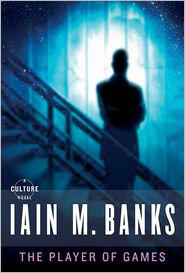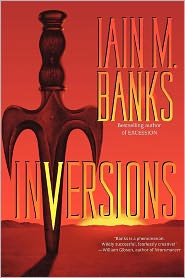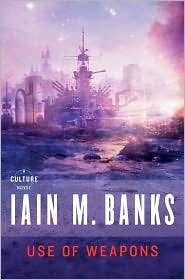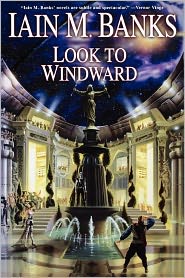5 Reasons Iain M. Banks’ Culture Should Be the Next Big Sci-Fi Adaptation
 It’s a wonderful time to be a science fiction fan. The television adaptation of James S.A. Corey’s Expanse space opera series is poised to drag SyFy back from the brink. Ann Leckie’s excellent Ancillary Justice has been optioned, as has basically everything with John Scalzi’s name on the cover, from Lock In, to Redshirts , to The Ghost Brigades.
It’s a wonderful time to be a science fiction fan. The television adaptation of James S.A. Corey’s Expanse space opera series is poised to drag SyFy back from the brink. Ann Leckie’s excellent Ancillary Justice has been optioned, as has basically everything with John Scalzi’s name on the cover, from Lock In, to Redshirts , to The Ghost Brigades.
But there’s one series I don’t see on those in-development lists, and it boggles my mind. For years now, we’ve been teased by rumors of plans to adapt Iain M. Banks’ Culture novels, but they’ve remained just that—rumors. This must change. The Culture is space opera on a grand-scale, set in a hedonistic utopian society watched over by benevolent artificial intelligences. Collectively, it is one of the most brilliant works of sci-fi ever created, but apart from a few whispers about a movie deal, not one of its 10 books has even come close to hitting the screen (big or small). That’s an absolute shame, and here’s why.
The Player of Games (Culture Series #2)
The Player of Games (Culture Series #2)
In Stock Online
Paperback $19.99
5. It’s packed with action…
I’ll go with the easiest first: the Culture is a series full of big, brilliant, beautiful action scenes. The very first book, Consider Phlebas, starts in the middle of an interstellar war. There’s a firefight with a scout ship that thinks in four dimensions. Two or three chapters later, a group of space pirates attempt a forced landing on a massive, ring-shaped space station. This is a series of titanic battles over something as simple as board games. In one book, the Culture invades Hell itself (or at least a virtual-reality simulacrum) and stands poised to take on bigger threats still. In these days of CGI miracles, these stunning set pieces would redefine the genre on the small screen. Provided there’s network that could afford to create them…
5. It’s packed with action…
I’ll go with the easiest first: the Culture is a series full of big, brilliant, beautiful action scenes. The very first book, Consider Phlebas, starts in the middle of an interstellar war. There’s a firefight with a scout ship that thinks in four dimensions. Two or three chapters later, a group of space pirates attempt a forced landing on a massive, ring-shaped space station. This is a series of titanic battles over something as simple as board games. In one book, the Culture invades Hell itself (or at least a virtual-reality simulacrum) and stands poised to take on bigger threats still. In these days of CGI miracles, these stunning set pieces would redefine the genre on the small screen. Provided there’s network that could afford to create them…
Inversions (Culture Series #5)
Inversions (Culture Series #5)
Paperback $22.95
4. There’s also plenty of intrigue
So maybe big, bright action isn’t your thing. Maybe you’re more appreciative of the backstabbing and political dealing of Game of Thrones. The books have you covered there, too. The Culture is an egalitarian utopia that prefers not to use force whenever possible, choosing instead to act through elaborate schemes and subterfuge. The artificial minds behind “Special Circumstances” (the covert ops arm of the Culture) create multi-tiered plots so intricate, a person in complete defiance of their edicts can be fooled into doing doing exactly what the Culture wants without ever realizing it. The antagonists are no slouches, either: Inversions is about a dense conspiracy that the Culture doesn’t have a direct hand in, and while Special Circumstances does intervene in the action in Matter, the protagonists are already embroiled in several ongoing intrigues.
4. There’s also plenty of intrigue
So maybe big, bright action isn’t your thing. Maybe you’re more appreciative of the backstabbing and political dealing of Game of Thrones. The books have you covered there, too. The Culture is an egalitarian utopia that prefers not to use force whenever possible, choosing instead to act through elaborate schemes and subterfuge. The artificial minds behind “Special Circumstances” (the covert ops arm of the Culture) create multi-tiered plots so intricate, a person in complete defiance of their edicts can be fooled into doing doing exactly what the Culture wants without ever realizing it. The antagonists are no slouches, either: Inversions is about a dense conspiracy that the Culture doesn’t have a direct hand in, and while Special Circumstances does intervene in the action in Matter, the protagonists are already embroiled in several ongoing intrigues.
Excession (Culture Series #4)
Excession (Culture Series #4)
Paperback $10.99
3. The cast is diverse
Diversity and reputation in SFF is one of the most widely discussed issues in the genre today. Iain Banks may have been an OWG (Old White Guy), but he never steered away from including a diverse array of races and genders among his protagonists. The Culture features men, women, aliens (who are actually alien, and not humanoids with fancy foreheads), transgendered people, transspecies people, a wide spectrum of sexualities, and characters of every possible creed, color, and (pardon the pun) culture. Technology has even advanced sufficiently to allow characters to change genders over the course of a novel, both fathering and giving birth to children along the way. Given how many fans are clamoring for more diverse casts, the Culture would be a perfect solution—if faithfully adapted, that is.
3. The cast is diverse
Diversity and reputation in SFF is one of the most widely discussed issues in the genre today. Iain Banks may have been an OWG (Old White Guy), but he never steered away from including a diverse array of races and genders among his protagonists. The Culture features men, women, aliens (who are actually alien, and not humanoids with fancy foreheads), transgendered people, transspecies people, a wide spectrum of sexualities, and characters of every possible creed, color, and (pardon the pun) culture. Technology has even advanced sufficiently to allow characters to change genders over the course of a novel, both fathering and giving birth to children along the way. Given how many fans are clamoring for more diverse casts, the Culture would be a perfect solution—if faithfully adapted, that is.
Use of Weapons (Culture Series #3)
Use of Weapons (Culture Series #3)
In Stock Online
Paperback $19.99
2. It has a great sense of humor
While it’s never a very happy series, Banks’ Culture novels display a uniformly excellent sense of humor. Whether it’s the intelligent ships who have given themselves names like We Haven’t Met But You’re A Great Fan Of Mine, Conflict Of Interest, and So Much for Subtlety, Cheradine Zakalwe’s unusual chair phobia [Editor’s note: You thought that was funny? You are a dark, dark man.], or a running gag sparked when someone told the artificial Minds to name their ships with “a little more gravitas” (which they took way too seriously), there’s a dark, quirky sense of humor at work throughout the series, hitting the right balance between unnerving, absurd, and hilarious.
2. It has a great sense of humor
While it’s never a very happy series, Banks’ Culture novels display a uniformly excellent sense of humor. Whether it’s the intelligent ships who have given themselves names like We Haven’t Met But You’re A Great Fan Of Mine, Conflict Of Interest, and So Much for Subtlety, Cheradine Zakalwe’s unusual chair phobia [Editor’s note: You thought that was funny? You are a dark, dark man.], or a running gag sparked when someone told the artificial Minds to name their ships with “a little more gravitas” (which they took way too seriously), there’s a dark, quirky sense of humor at work throughout the series, hitting the right balance between unnerving, absurd, and hilarious.
Look to Windward (Culture Series #6)
Look to Windward (Culture Series #6)
Paperback $23.99
1. The setting is huge. As in, properly huge.
The series’ most impressive characteristic is its sheer scale. There are ships that can self-manufacture battle fleets large enough to kill a planet. Orbital ring colonies that encircle a star. Truly alien races. And all of it feels completely unique. Banks hardly repeats himself across 10 length novels, and even when he revisits a theme or locale, he manages to make it feel historic and organic. To wit: the Culture’s meddling during the Idiran-Culture War of Consider Phlebas provides the seed for the plot of Look To Windward, which takes place centuries later. Banks’ world-building is so dense, a TV series based on it could range far and wide from the plots of the novels and still never run out of material.
The Culture is the sci-fi TV series we need. It’s the sci-fi TV series we deserve. An adaptation has been teased since 1988. It needs to be the next big thing to make the leap to the screen.
1. The setting is huge. As in, properly huge.
The series’ most impressive characteristic is its sheer scale. There are ships that can self-manufacture battle fleets large enough to kill a planet. Orbital ring colonies that encircle a star. Truly alien races. And all of it feels completely unique. Banks hardly repeats himself across 10 length novels, and even when he revisits a theme or locale, he manages to make it feel historic and organic. To wit: the Culture’s meddling during the Idiran-Culture War of Consider Phlebas provides the seed for the plot of Look To Windward, which takes place centuries later. Banks’ world-building is so dense, a TV series based on it could range far and wide from the plots of the novels and still never run out of material.
The Culture is the sci-fi TV series we need. It’s the sci-fi TV series we deserve. An adaptation has been teased since 1988. It needs to be the next big thing to make the leap to the screen.




